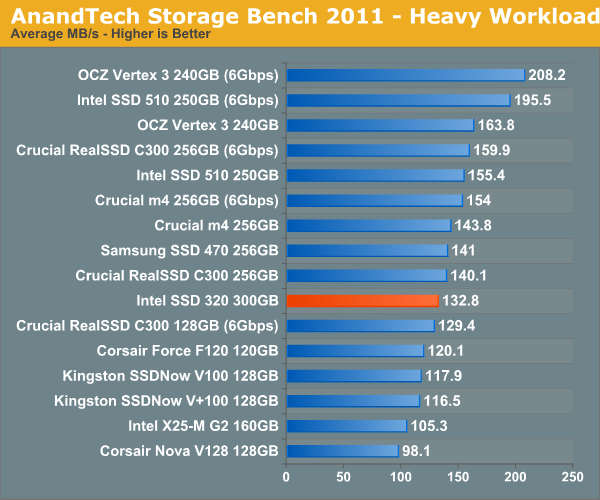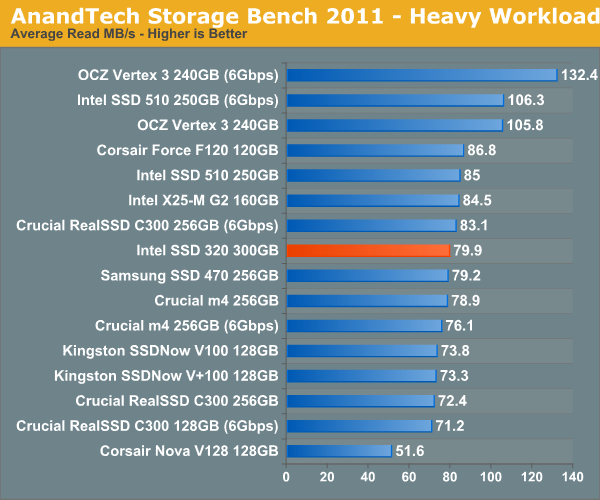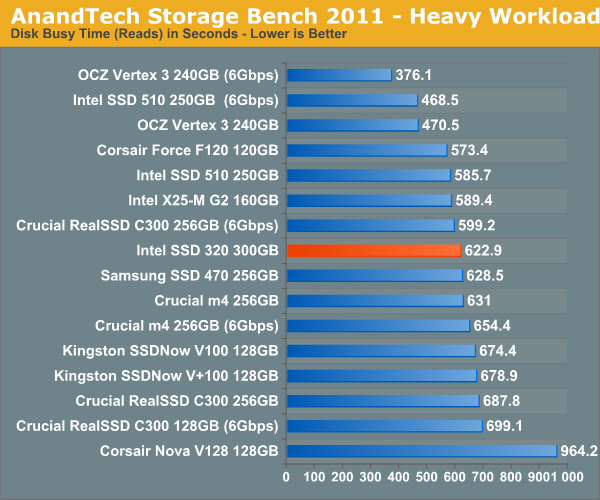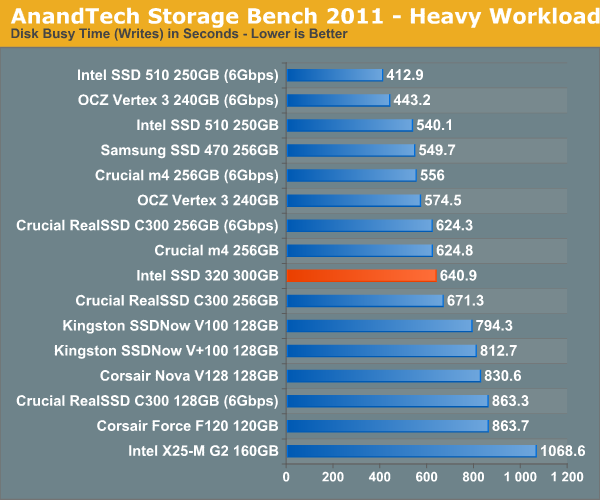The Intel SSD 320 Review: 25nm G3 is Finally Here
by Anand Lal Shimpi on March 28, 2011 11:08 AM EST- Posted in
- IT Computing
- Storage
- SSDs
- Intel
- Intel SSD 320
AnandTech Storage Bench 2011: Much Heavier
I didn't expect to have to debut this so soon, but I've been working on updated benchmarks for 2011. Last year we introduced our AnandTech Storage Bench, a suite of benchmarks that took traces of real OS/application usage and played them back in a repeatable manner. I assembled the traces myself out of frustration with the majority of what we have today in terms of SSD benchmarks.
Although the AnandTech Storage Bench tests did a good job of characterizing SSD performance, they weren't stressful enough. All of the tests performed less than 10GB of reads/writes and typically involved only 4GB of writes specifically. That's not even enough exceed the spare area on most SSDs. Most canned SSD benchmarks don't even come close to writing a single gigabyte of data, but that doesn't mean that simply writing 4GB is acceptable.
Originally I kept the benchmarks short enough that they wouldn't be a burden to run (~30 minutes) but long enough that they were representative of what a power user might do with their system.
Not too long ago I tweeted that I had created what I referred to as the Mother of All SSD Benchmarks (MOASB). Rather than only writing 4GB of data to the drive, this benchmark writes 106.32GB. It's the load you'd put on a drive after nearly two weeks of constant usage. And it takes a *long* time to run.
I'll be sharing the full details of the benchmark in some upcoming SSD articles but here are some details:
1) The MOASB, officially called AnandTech Storage Bench 2011 - Heavy Workload, mainly focuses on the times when your I/O activity is the highest. There is a lot of downloading and application installing that happens during the course of this test. My thinking was that it's during application installs, file copies, downloading and multitasking with all of this that you can really notice performance differences between drives.
2) I tried to cover as many bases as possible with the software I incorporated into this test. There's a lot of photo editing in Photoshop, HTML editing in Dreamweaver, web browsing, game playing/level loading (Starcraft II & WoW are both a part of the test) as well as general use stuff (application installing, virus scanning). I included a large amount of email downloading, document creation and editing as well. To top it all off I even use Visual Studio 2008 to build Chromium during the test.
Many of you have asked for a better way to really characterize performance. Simply looking at IOPS doesn't really say much. As a result I'm going to be presenting Storage Bench 2011 data in a slightly different way. We'll have performance represented as Average MB/s, with higher numbers being better. At the same time I'll be reporting how long the SSD was busy while running this test. These disk busy graphs will show you exactly how much time was shaved off by using a faster drive vs. a slower one during the course of this test. Finally, I will also break out performance into reads, writes and combined. The reason I do this is to help balance out the fact that this test is unusually write intensive, which can often hide the benefits of a drive with good read performance.
There's also a new light workload for 2011. This is a far more reasonable, typical every day use case benchmark. Lots of web browsing, photo editing (but with a greater focus on photo consumption), video playback as well as some application installs and gaming. This test isn't nearly as write intensive as the MOASB but it's still multiple times more write intensive than what we were running last year.
As always I don't believe that these two benchmarks alone are enough to characterize the performance of a drive, but hopefully along with the rest of our tests they will help provide a better idea.
The testbed for Storage Bench 2011 has changed as well. We're now using a Sandy Bridge platform with full 6Gbps support for these tests. All of the older tests are still run on our X58 platform.
AnandTech Storage Bench 2011 - Heavy Workload
We'll start out by looking at average data rate throughout our new heavy workload test:

Overall performance is decidedly last generation. The 320 is within striking distance of the 510 but is slower overall in our heavy workload test.
The breakdown of reads vs. writes tells us more of what's going on:


The next three charts just represent the same data, but in a different manner. Instead of looking at average data rate, we're looking at how long the disk was busy for during this entire test. Note that disk busy time excludes any and all idles, this is just how long the SSD was busy doing something:













194 Comments
View All Comments
semo - Monday, March 28, 2011 - link
Anand, it has been a long time now. People are still confused about what is happening with the OCZ V2 drives. OCZ are still not issuing a recall of drives that are smaller and slower than what the packaging claims.OCZ will only react when the customer finds out through their own research what has happened and then confronts OCZ.
For those wanting to know more, see my thread below or research the OCZ Vertex 2 25nm transition fiasco.
http://forums.anandtech.com/showthread.php?t=21433...
The issue will not be resolved until OCZ recalls all affected products.
GeorgeH - Monday, March 28, 2011 - link
It looks like the crucial parts are physically identical to G2 drives. Intel may not offer updated firmware for G2 drives, but it looks like it might not be impossibly difficult to modify G3 firmware to work on G2 drives.Did Intel give any indication if the G2 controllers were physically different from the G3s? In other words did Intel take the laser scalpel to the G2 controllers or is it just a software restriction?
Chloiber - Monday, March 28, 2011 - link
Anand explained why the write performance is higher (4kB -> 8kB).GeorgeH - Monday, March 28, 2011 - link
Sure, but full disk encryption might be nice.Anand Lal Shimpi - Monday, March 28, 2011 - link
The G2 controller had the same features as the 320's controller. It's unclear whether they were tested/functional in the G2 era but they were there. The 320's controller is apparently the same physical die, just with these new features enabled/tested/validated.G1 owners didn't get TRIM, and I wouldn't expect G2 owners to get AES-128 via firmware. Sorry :(
bbbcase - Monday, March 28, 2011 - link
The Intel G1/G2 drives would eventually throttle write performance if you consistently wrote over 20GB/day on them to ensure warranty lifetime. This really limited their usefulness in certain server applications.Does the G3 have a similar throttling mechanism?
Chloiber - Monday, March 28, 2011 - link
?? They didn't. The block fragmentation will, in spite of TRIM increase (that's the case with pretty much every SSD). Write 0s sequentially on the empty space every 2 months and the performance will always be as it was on the first day.You can also do this by doing a Full Diagnostics Scan using the Intel SSD Toolbox (writes sequentially on the empty space).
toyotabedzrock - Monday, March 28, 2011 - link
I'm curious if a 8KB random R/W test would show a bump in speed beyond what other drives would see.Intel really needs to get serious about allocating people to the SSD and Chipset teams. They always make a quick leap with a great new chip then it languishes for years with minor updates.
Pentium 4 flashbacks!
cdbob - Monday, March 28, 2011 - link
I heard rumors that pricing was going to be on the steep side. It's too bad this turned out to be true, Intel better lower the price of their drives quick or they're going to start eating some serious dust when the next crop of Crucial Drives come out.Beenthere - Monday, March 28, 2011 - link
That's why I won't buy any SSD for at least five more years. Poor reliability and data loss don't work for me.